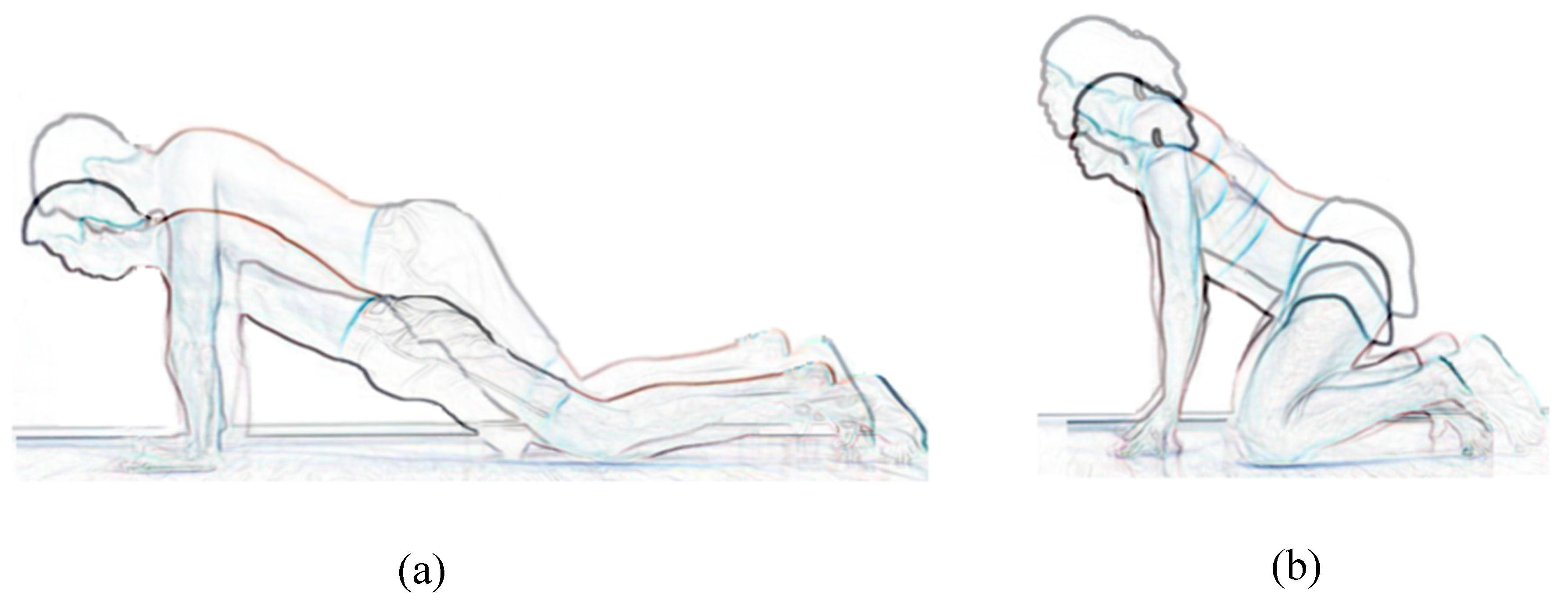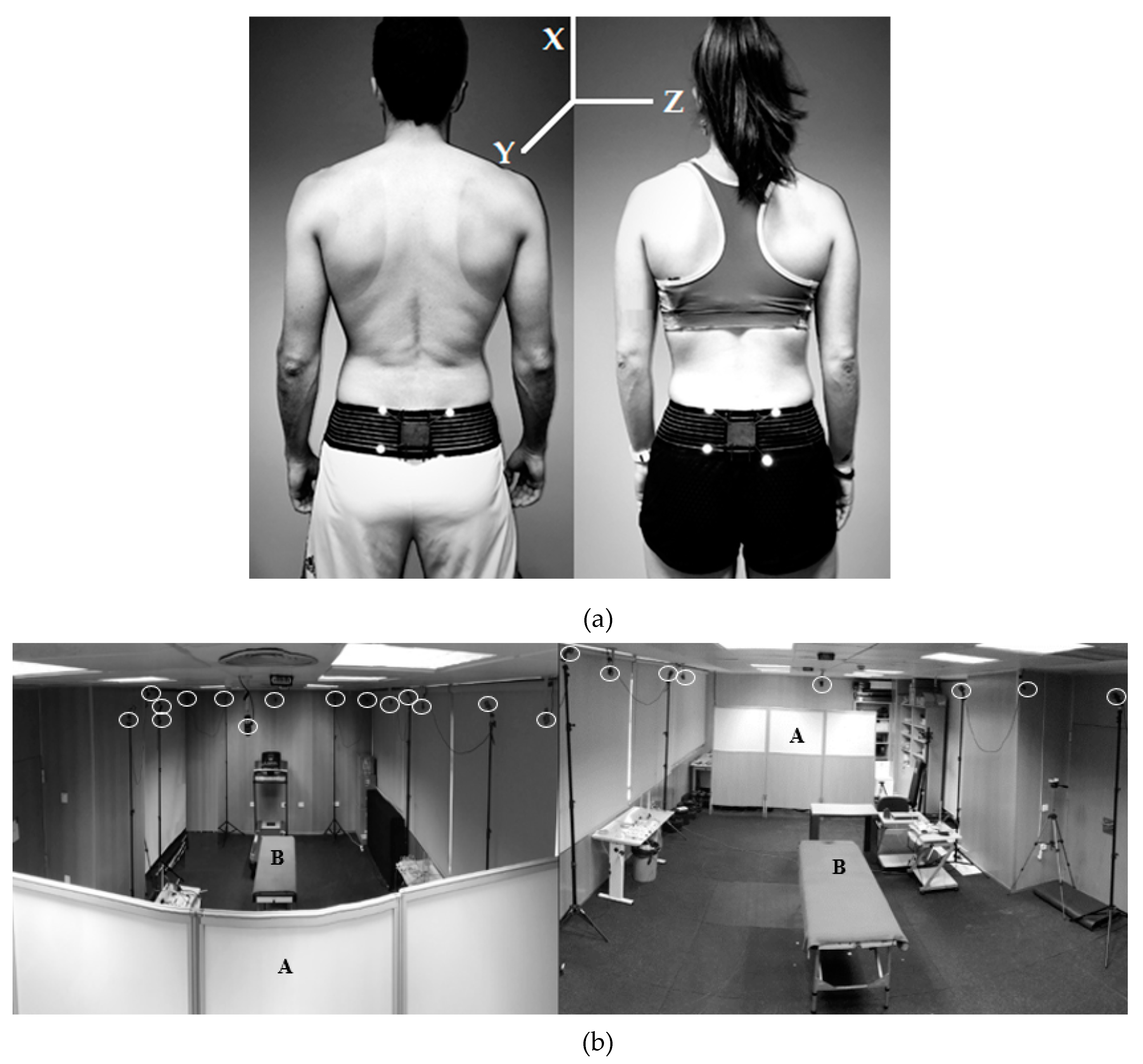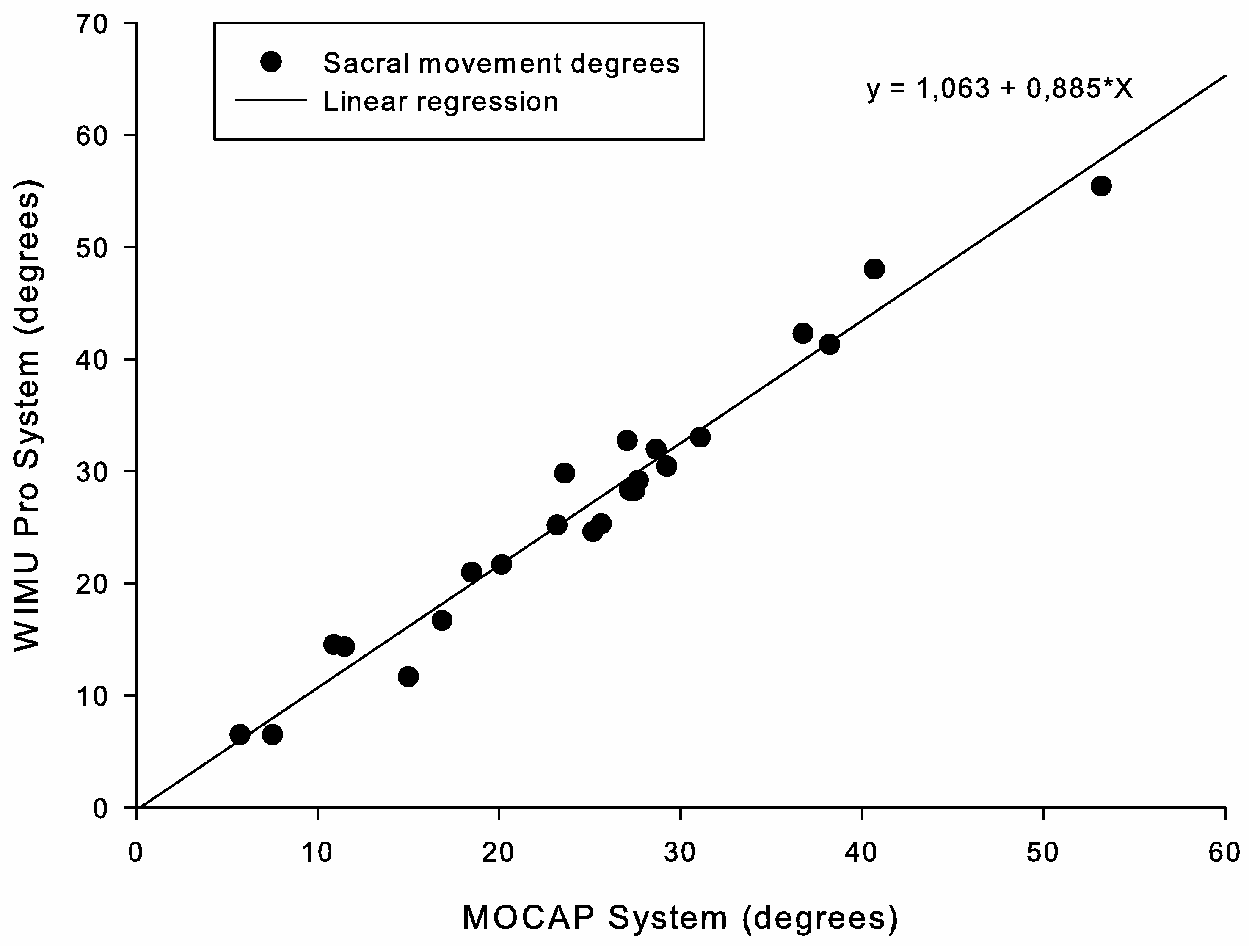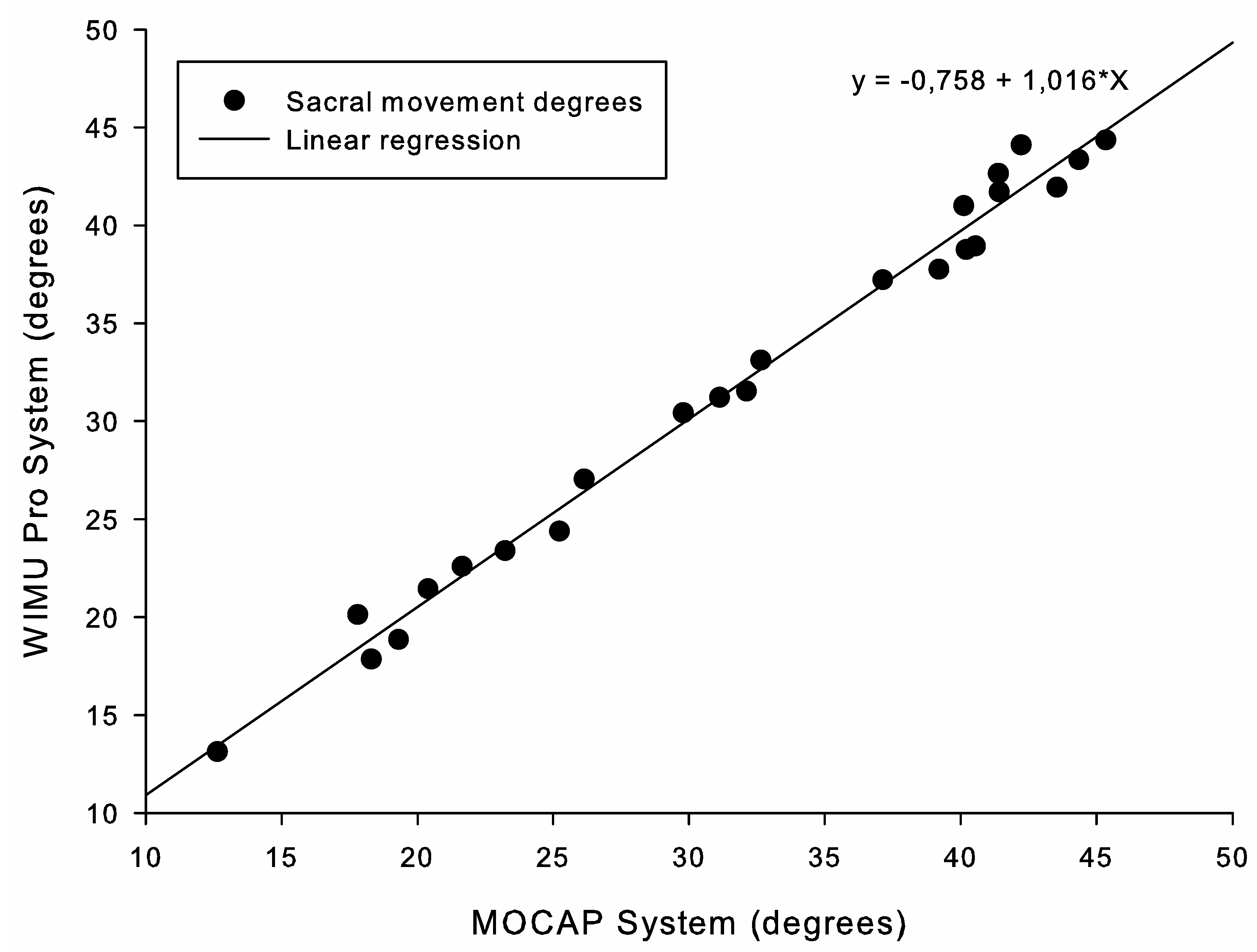Validity and Reliability of a New Inertial Device for Monitoring Range of Motion at the Pelvis during Sexual Intercourse
Abstract
1. Introduction
2. Materials and Methods
2.1. Participants
2.2. Procedure
2.3. Instruments
2.4. Data Synchronization from Both Instruments
2.5. Statistical Analysis
3. Results
4. Discussion
5. Conclusions
Author Contributions
Funding
Acknowledgments
Conflicts of Interest
References
- Levin, R.J. Sexual activity, health and well-being—The beneficial roles of coitus and masturbation. Sex. Relatsh. Ther. 2007, 22, 135–148. [Google Scholar] [CrossRef]
- Lindau, S.T.; Gavrilova, N. Sex, health, and years of sexually active life gained due to good health: Evidence from two US population based cross sectional surveys of ageing. BMJ 2010, 340, 580–590. [Google Scholar] [CrossRef] [PubMed]
- Wright, H.; Jenks, R.A. Sex on the brain! Associations between sexual activity and cognitive function in older age. Age Ageing 2016, 45, 313–317. [Google Scholar] [CrossRef] [PubMed]
- Magon, N.; Kalra, S. The orgasmic history of oxytocin: Love, lust, and labor. Indian J. Endocrinol. Metab. 2011, 15, 156–161. [Google Scholar] [CrossRef]
- Legros, J.J. Inhibitory effect of oxytocin on corticotrope function in humans: Are vasopressin and oxytocin ying-yang neurohormones? Psychoneuroendocrinology 2001, 26, 649–655. [Google Scholar] [CrossRef]
- Myers, J. Exercise and cardiovascular health. Circulation 2003, 107, 2–5. [Google Scholar] [CrossRef] [PubMed]
- Caspersen, C.J.; Powell, K.E.; Christenson, G.M. Physical activity, exercise, and physical fitness: Definitions and distinctions for health-related research. Public Health Rep. 1985, 100, 126–131. [Google Scholar] [PubMed]
- Ainsworth, B.E.; Haskell, W.L.; Leon, A.S.; Jacobs, D.R.; Montoye, H.J.; Sallis, J.F.; Paffenbarger, R.S. Compendium of Physical Activities: Classification of energy costs of human physical activities. Med. Sci. Sports Exerc. 1993, 25, 71–80. [Google Scholar] [CrossRef]
- Frappier, J.; Toupin, I.; Levy, J.J.; Aubertin-Leheudre, M.; Karelis, A.D. Energy expenditure during sexual activity in young healthy couples. PLoS ONE 2013, 8, e79342. [Google Scholar] [CrossRef]
- Liu, H.; Waite, L.J.; Shen, S.; Wang, D.H. Is sex good for your health? A national study on partnered sexuality and cardiovascular risk among older men and women. J. Health Soc. Behav. 2016, 57, 276–296. [Google Scholar] [CrossRef]
- Sidorkewicz, N.; McGill, S.M. Documenting female spine motion during coitus with a commentary on the implications for the low back pain patient. Eur. Spine J. 2014, 24, 513–520. [Google Scholar] [CrossRef]
- Sidorkewicz, N.; McGill, S.M. Male spine motion during coitus. Spine 2014, 39, 1633–1639. [Google Scholar] [CrossRef] [PubMed][Green Version]
- Maigne, J.-Y.; Chatellier, G. Assessment of sexual activity in patients with back pain compared with patients with neck pain. Clin. Orthop. Relat. Res. 2001, 385, 82–87. [Google Scholar] [CrossRef] [PubMed]
- Charbonnier, C.; Chagué, S.; Ponzoni, M.; Bernardoni, M.; Hoffmeyer, P.; Christofilopoulos, P. Sexual activity after total hip arthroplasty: A motion capture study. J. Arthroplasty 2014, 29, 640–647. [Google Scholar] [CrossRef] [PubMed]
- Poitras, I.; Dupuis, F.; Bielmann, M.; Campeau-Lecours, A.; Mercier, C.; Bouyer, L.; Roy, J.-S. Validity and reliability of wearable sensors for joint angle estimation: A systematic review. Sensors 2019, 19, 1555. [Google Scholar] [CrossRef] [PubMed]
- Gómez-Carmona, C.D.; Bastida-Castillo, A.; García-Rubio, J.; Ibáñez, S.J.; Pino-Ortega, J. Static and dynamic reliability of WIMU PROTM accelerometers according to anatomical placement. Proc. Inst. Mech. Eng. Part P J. Sport. Eng. Technol. 2019, 233, 238–248. [Google Scholar]
- Guiry, J.J.; van de Ven, P.; Nelson, J. Multi-sensor fusion for enhanced contextual awareness of everyday activities with ubiquitous devices. Sensors 2014, 14, 5687–5701. [Google Scholar] [CrossRef] [PubMed]
- Fong, D.; Chan, Y.-Y. The use of wearable inertial motion sensors in human lower limb biomechanics studies: A systematic review. Sensors 2010, 10, 11556–11565. [Google Scholar] [CrossRef]
- Ciuti, G.; Nardi, M.; Valdastri, P.; Menciassi, A.; Basile Fasolo, C.; Dario, P. HuMOVE: A low-invasive wearable monitoring platform in sexual medicine. Urology 2014, 84, 976–981. [Google Scholar] [CrossRef]
- Faul, F.; Erdfelder, E.; Lang, A.G.; Buchner, A. G*Power 3: A flexible statistical power analysis program for the social, behavioral, and biomedical sciences. Behav. Res. Methods 2007, 39, 175–191. [Google Scholar] [CrossRef]
- O’Sullivan, K.; O’Sullivan, L.; Campbell, A.; O’Sullivan, P.; Dankaerts, W. Towards monitoring lumbo-pelvic posture in real-life situations: Concurrent validity of a novel posture monitor and a traditional laboratory-based motion analysis system. Man. Ther. 2012, 17, 77–83. [Google Scholar] [CrossRef] [PubMed]
- Dai, J.S. Euler-Rodrigues formula variations, quaternion conjugation and intrinsic connections. Mech. Mach. Theory 2015, 92, 144–152. [Google Scholar] [CrossRef]
- Carse, B.; Meadows, B.; Bowers, R.; Rowe, P. Affordable clinical gait analysis: An assessment of the marker tracking accuracy of a new low-cost optical 3D motion analysis system. Physiotherapy 2013, 99, 347–351. [Google Scholar] [CrossRef] [PubMed]
- Muyor, J.M.; Arrabal-Campos, F.M.; Martínez-Aparicio, C.; Sánchez-Crespo, A.; Villa-Pérez, M. Test-retest reliability and validity of a motion capture (MOCAP) system for measuring thoracic and lumbar spinal curvatures and sacral inclination in the sagittal plane. J. Back Musculoskelet. Rehabil. 2017, 30, 1319–1325. [Google Scholar] [CrossRef] [PubMed]
- Cohen, J. Statistical Power Analysis for the Behavioral Sciences, 2nd ed.; L. Erlbaum Associates: Hillsdale, NJ, USA, 1988; ISBN 9780805802832. [Google Scholar]
- Ludbrook, J. Statistical techniques for comparing measurers and methods of measurement: A critical review. Clin. Exp. Pharmacol. Physiol. 2002, 29, 527–536. [Google Scholar] [CrossRef] [PubMed]
- Shrout, P.E.; Fleiss, J.L. Intraclass correlations: Uses in assessing rater reliability. Psychol. Bull. 1979, 86, 420–428. [Google Scholar] [CrossRef]
- Atkinson, G.; Nevill, A.M. Statistical methods for assessing measurement error (reliability) in variables relevant to sports medicine. Sports Med. 1998, 26, 217–238. [Google Scholar] [CrossRef]
- Muyor, J.M. Validity and reliability of a new device (WIMU®) for measuring hamstring muscle extensibility. Int. J. Sports Med. 2017, 38, 691–695. [Google Scholar] [CrossRef]
- Goodvin, C.; Park, E.J.; Huang, K.; Sakaki, K. Development of a real-time three-dimensional spinal motion measurement system for clinical practice. Med. Biol. Eng. Comput. 2006, 44, 1061–1075. [Google Scholar] [CrossRef]
- Picerno, P.; Cereatti, A.; Cappozzo, A. Joint kinematics estimate using wearable inertial and magnetic sensing modules. Gait Posture 2008, 28, 588–595. [Google Scholar] [CrossRef]
- Zhang, J.-T.; Novak, A.C.; Brouwer, B.; Li, Q. Concurrent validation of Xsens MVN measurement of lower limb joint angular kinematics. Physiol. Meas. 2013, 34, 63–69. [Google Scholar] [CrossRef]
- Chhikara, A.; McGregor, A.H.; Hadjilucas, L.; Bello, F.; Rice, A.S. Quantitative assessment of the motion of the lumbar spine and pelvis with wearable inertial sensors. In Proceedings of the IEEE 2010 International Conference on Body Sensor Networks, Singapore, 7–9 June 2010; pp. 9–15. [Google Scholar]
- Wong, W.Y.; Wong, M.S. Trunk posture monitoring with inertial sensors. Eur. Spine J. 2008, 17, 743–753. [Google Scholar] [CrossRef] [PubMed]
- Walgaard, S.; Faber, G.S.; van Lummel, R.C.; van Dieën, J.H.; Kingma, I. The validity of assessing temporal events, sub-phases and trunk kinematics of the sit-to-walk movement in older adults using a single inertial sensor. J. Biomech. 2016, 49, 1933–1937. [Google Scholar] [CrossRef] [PubMed]
- Charlton, P.C.; Mentiplay, B.F.; Pua, Y.-H.; Clark, R.A. Reliability and concurrent validity of a Smartphone, bubble inclinometer and motion analysis system for measurement of hip joint range of motion. J. Sci. Med. Sport 2015, 18, 262–267. [Google Scholar] [CrossRef] [PubMed]





| Slow Pace | Fast Pace | |
|---|---|---|
| WIMU Pro (95% CI; °) | 24.91 ± 10.92 * (19.91–29.27) | 31.01 ± 11.96 (24.64–37.83) |
| Flex3 cameras (95% CI; °) | 26.96 ± 12.13 (20.62–29.65) | 31.26 ± 11.72 (24.56–37.01) |
| Systematic bias (°) | −2.04 ± 2.45 | −0.25 ± 0.24 |
| Cohen’s d | 0.17 | 0.02 |
| SEM (°) | 2.34 | 2.96 |
| R2 correlation | 0.96 * | 0.98 * |
| ICC (95% CI) | 0.981 (0.894–0.994) * | 0.998 (0.993–0.999) * |
| Variable | WIMU Pro | Flex3 Cameras | ||
|---|---|---|---|---|
| Slow Pace | Fast Pace | Slow Pace | Fast Pace | |
| Set 1 (95% CI; °) | 24.69 ± 11.31 (19.91–29.27) | 31.24 ± 12.37 (24.64–37.83) | 26.38 ± 12.57 (21.07–31.69) | 31.39 ± 12.13 (24.92–37.85) |
| Set 2 (95% CI; °) | 25.14 ± 10.69 (20.62–29.65) | 30.78 ± 11.67 (24.56–37.01) | 27.54 ± 11.83 (22.54–32.54) | 31.13 ± 11.42 (25.05–37.22) |
| Systematic bias (°) | −0.44 ± 2.73 | 0.45 ± 2.50 | −1.16 ± 2.72 | 0.25 ± 2.35 |
| Cohen’s d | 0.04 | 0.03 | 0.09 | 0.02 |
| SEM (°) | 2.24 | 3.00 | 2.48 | 2.94 |
| CV (%) | 7.15 | 5.47 | 8.29 | 5.09 |
| ICC (95% CI) | 0.985 (0.965–0.993) * | 0.986 (0.964–0.994) * | 0.989 (0.970–0.996) * | 0.990 (0.973–0.997) * |
© 2020 by the authors. Licensee MDPI, Basel, Switzerland. This article is an open access article distributed under the terms and conditions of the Creative Commons Attribution (CC BY) license (http://creativecommons.org/licenses/by/4.0/).
Share and Cite
Oliva-Lozano, J.M.; Martín-Fuentes, I.; Muyor, J.M. Validity and Reliability of a New Inertial Device for Monitoring Range of Motion at the Pelvis during Sexual Intercourse. Int. J. Environ. Res. Public Health 2020, 17, 2884. https://doi.org/10.3390/ijerph17082884
Oliva-Lozano JM, Martín-Fuentes I, Muyor JM. Validity and Reliability of a New Inertial Device for Monitoring Range of Motion at the Pelvis during Sexual Intercourse. International Journal of Environmental Research and Public Health. 2020; 17(8):2884. https://doi.org/10.3390/ijerph17082884
Chicago/Turabian StyleOliva-Lozano, José M., Isabel Martín-Fuentes, and José M. Muyor. 2020. "Validity and Reliability of a New Inertial Device for Monitoring Range of Motion at the Pelvis during Sexual Intercourse" International Journal of Environmental Research and Public Health 17, no. 8: 2884. https://doi.org/10.3390/ijerph17082884
APA StyleOliva-Lozano, J. M., Martín-Fuentes, I., & Muyor, J. M. (2020). Validity and Reliability of a New Inertial Device for Monitoring Range of Motion at the Pelvis during Sexual Intercourse. International Journal of Environmental Research and Public Health, 17(8), 2884. https://doi.org/10.3390/ijerph17082884





